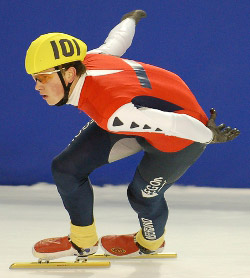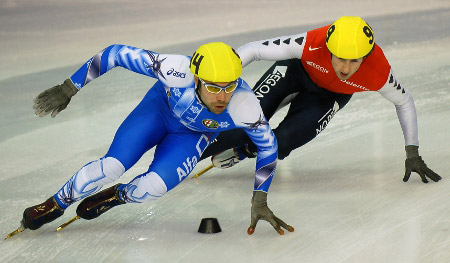Feature: Engineers Give Speed Skaters an Edge
 In a sport where just fractions of a second can separate a winner from the also-rans, engineering makes a big difference. Speed skating, for instance, once depended on endurance and brute force. Now, it’s as much a feat of science and technology as strength.
In a sport where just fractions of a second can separate a winner from the also-rans, engineering makes a big difference. Speed skating, for instance, once depended on endurance and brute force. Now, it’s as much a feat of science and technology as strength.
Two major innovations have radically altered the sport.
One is the “slap skate,” which was invented in the Netherlands in the 1890s, but wasn’t widely used until 1996. It features a hinge that allows the sharp skate blade to disconnect from the back of the skater’s boot, distributing the skater’s energy more evenly. Athletes wearing this type of footwear are able to use more of their calves and knees in pushing off the ice. This allows more force to be applied, and for longer, since the blade rarely leaves the ice.
The second is the suit, designed to reduce the skater’s wind resistance, or drag, as much as possible. Twenty five percent of the friction a speed skater faces comes from the ice, but 75 percent is air resistance.
The leading company that makes “swift suits” is Nike, which tested more than 100 types of fabrics and coatings before coming up with a special design that has rough fabric on the arms and legs and a smooth surface on the torso. Swift suits are developed for multiple sports, and they are tailored to fit different events within speed skating, such as Short Track, depending on the distance covered. Nike claims that athletes who wear its swift suits in the Olympic Games are, on average, one percent faster than those who wear other companies’ suits.
The suit is actually more aerodynamic than bare human skin, studies show, because subcutaneous fat, even on the sleekest athlete, wrinkles as the body speeds up and increases air resistance. The aerodynamic material is tested in special wind tunnel labs. Under Olympic rules, no attachments are allowed to the suit other than a hood.
In addition to wearing engineered gear, the athletes often tuck one arm behind their backs to reduce drag. Skaters may “draft” other racers to reduce air drag by using the leading skater’s body as a shield, thus letting the pursuing skater expend less energy. When cornering, they may also tilt close to the ground with one or both hands touching the ice, which allows for faster and more precise pivoting.

The Canadian Olympic Committee hopes to dominate the Vancouver Games, spending up to a quarter of its more than $110 million budget on technological improvements and advanced training. On this year’s list: even faster speed skating suits.
Although the main factors in the outcome of a race are skill and human error, sports engineering leaves less and less to chance. Occasionally, though, an athlete can triumph through sheer luck, and the main factors in the outcome of a race are skill and human error.
In 2002, Australia’s Steven Bradbury won the 1,000 meter Olympic speed skating race. He was in last place the entire time — until one of the lead skaters crashed into the rest of the pack. They all wiped out… except Bradbury, who skated around the mess and took home a gold medal.
5000 Relay Heats Men Photos 1 and 2 by John Thescone
Test your (or your students’) knowledge of speed skating with this crossword puzzle!
Filed under: Special Features
Tags: Amazing Engineering, Feature Story, Olympics, Sports Engineering








